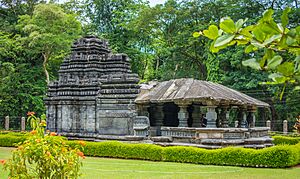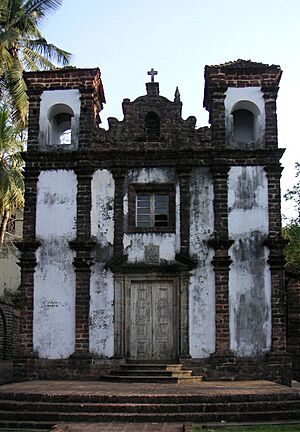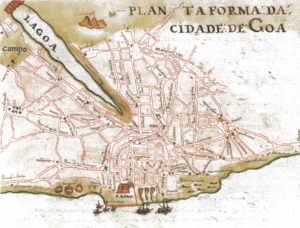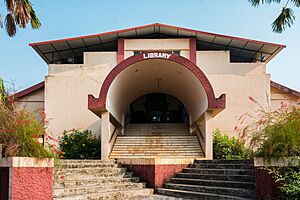History of Goa facts for kids
The history of Goa goes back to ancient times, even though the state we know today was only formed in 1987. Goa is India's smallest state, but it has a long and interesting past. Its history is much like the rest of Indian history, especially with its mix of cultures and influences from colonial times.
Some of the earliest signs of people living in India are found in Goa. These are the Usgalimal rock engravings, which are from the Stone Age. Later, powerful empires like the Mauryan and Satavahana ruled Goa during the Iron Age.
In the medieval period, Goa was controlled by several kingdoms. These included the Kadamba kingdom, the Vijayanagara Empire, the Bahmani Sultanate, and the Bijapur Sultanate.
The Kadamba dynasty ruled Goa from the 2nd century CE until 1312. Then, Muslim rulers from the Deccan took over from 1312 to 1367. After that, the Hindu kingdom of Vijayanagara took control. Later, the Bahmanī sultanate conquered Goa and founded Old Goa in 1440.
The Portuguese arrived in 1510 and defeated the Bijapur Sultanate. Their rule lasted for about 450 years. This long period greatly shaped Goan culture, food, and buildings.
In 1961, India took control of Goa after a short battle. Goa became part of the Goa, Daman and Diu territory. In 1987, after a movement for the Konkani language, Goa became a full state. Today, Goa has one of the highest incomes per person and development levels among Indian states.
Contents
Ancient Origins of Goa
Evidence shows that Goa's land was formed by earth movements around 10,000 BC. There are also signs that people lived in Goa as far back as the Stone Age. This is shown by old stone tools found in the Mandovi and Zuari river areas.
How Goa's Land Was Formed
Scientists believe that parts of Goa rose from the sea due to the movement of Earth's tectonic plates. This idea is supported by finding sea fossils and buried seashells in the coastal areas. Old fossilized branches found in the foothills of the Sahyadri mountains also date back over 10,000 BC. This suggests that Goa was lifted from the seabed by strong earth movements.
Early Human History
For a long time, people debated if humans lived in Goa during the Stone Age. But in 1993, rock art was found at Usgalimal near the Kushavati River. This discovery showed that people lived in Goa much earlier than thought. The rock shelter at Usgalimal could hold 25 to 30 people. A nearby stream provided water for Stone Age humans for centuries.
Pictures of a Mother goddess and tree-like shapes were found. This site was discovered by Dr P.P.Shirodkar. Other sites in the Mandovi-Zuari area also revealed tools like scrapers and axes. These findings suggest that people were living as hunter-gatherers in Goa long before farming began.
Kushavati Rock Art and Culture
The ancient rock carvings at Usgalimal were found in the early 1990s. More than 125 shapes were found along the Kushavati River. Scholars believe these carvings show a prehistoric shamanistic culture in Goa. For many years, locals called them "pictures made by cowherds" without knowing their true age or meaning.
Studies show that the Kushavati people were hunter-gatherers. They knew a lot about local plants, animals, and seasons. They were very concerned about having enough water and set up camps near streams. This culture is believed to be 6,000 to 8,000 years old.
Neolithic Period and Early Settlers
Archaeological finds, like polished stone axes in Goa Velha, suggest the first farming settlements in Goa. During this time, tribes like the Kols, Mundaris, and Kharvis might have settled in Goa. They lived by hunting, fishing, and simple farming around 3500 BC. Some historians believe that today's Gauda and Kunbi castes are descendants of these ancient tribes.
These early people began to worship a mother goddess, often in the form of an anthill called Santer. This worship of anthills still continues in Goa today.
Iron Age (from 16th century BCE)
Village Communities and Self-Rule
In ancient Goa, a system of village administration called Gaumkari developed. This system allowed villagers to jointly own agricultural land. They could rent out the land, use the money for village development, and share the rest among themselves. The village's main temple was the center of all activities.
This Gaumkari system, also called Gaumponn, existed long before any kings ruled Goa. Even when different rulers came and went, the Gaumponn remained. This is why Goans have always felt a strong connection to their villages. Even today, many comunidades still operate in Goa.
Later Migrations to Goa
Around 1700 to 1400 BC, a second wave of people arrived in Goa. These were southern Indians from the Deccan plateau. Some people from the Harappan civilization also moved to areas like Lothal around 1600 BC. This mixing of different cultures, customs, and beliefs brought big changes to early Goan society.
Maurya Empire's Influence
Chandragupta Maurya added the west coast of India, including Goa, to his empire. The official language of the Mauryan Empire, Magadhan Prakrit, influenced local dialects. This led to the formation of early Konkani. Buddhism was also brought to Goa during this time. A Goan named Purna, a direct student of Buddha, helped spread Buddhism in Goa in the 5th century BC.
Satavahana Rule (c. 2nd century BCE to 2nd CE)
The Satavahana dynasty ruled Goa through local leaders from around the 2nd century BC to 100 AD. They were a strong naval power and traded with the Roman empire. Greek and Roman ships would stop in Goa during their journeys. After the Satavahanas fell, trade declined. Many Greeks who converted to Buddhism settled in Goa, and Buddha statues in Greek styles have been found there.
Mauryas of Puri
The Mauryas of Puri ruled parts of Goa from the 4th to 7th centuries. Their capital was Kumardvipa, now Kumarjuve. At its peak, their kingdom included South Gujarat, coastal Maharashtra, Goa, and parts of North Kanara. Goa was known as Sunaparant during their rule.
Bhojas (c. 2nd century BCE to 4th CE)
The Bhojas ruled Goa for over 500 years, first as vassals and then as an independent kingdom. Their earliest record in Goa is from the 4th century in Shiroda. Ancient Chandrapur, now Chandor, was their capital. The Bhojas used Sanskrit and Prakrit for their administration. They supported Buddhism and employed many Greek and Persian converts.
Kingdoms and Later Medieval Period (1st century CE to 16th)
Goa was ruled by many different dynasties from the 1st century CE to 1500. During this time, Goa was not a single kingdom. Different parts were controlled by various rulers.
| Name of the ruler | Time Period |
|---|---|
| Indo-Parthians | 2nd–4th centuries AD |
| Abhiras, Batapuras, Bhojas | 4th–6th centuries |
| Chalukyas of Badami | 6th–8th centuries |
| Rashtrakutas of Malkhed, Shilaharas | 8th–10th centuries |
| Kadambas | 1006–1356 |
| Yadavas of Devagiri | 12th and 13th centuries |
| Vijayanagara Empire | 14th and 15th centuries |
| Bahmani Sultanate | 15th century |
Shilaharas (755 – 1000)
The Shilaharas of South Konkan ruled Goa from 755 to 1000 AD. Their capital was likely Chandrapura or Gopakapattana. This was a difficult time for Goa. As the Shilahara power weakened, Arab traders gained more control over sea trade. The Kadamba King, Shashthadeva II, then took advantage and established his rule in Goa.
Kadambas (10th century to 14th)
The Kadambas ruled Goa for over 400 years, from the 10th to the 14th centuries. They first ruled a small part of Konkan from Chandor.
Gopakapattana Port (10th century to 1345)
Later, King Shashthadeva conquered the island of Goa, including the important ports of Gopakapattana. He made Gopakapattana his second capital. This port traded with places like Zanzibar, Bengal, Gujarat, and Sri Lanka. Gopakapattana was known for its beauty and spiritual importance. It was a busy trading city, influenced by many cultures.
Under the Kadambas, Goa's religion, culture, trade, and arts flourished. The kings and queens built many Shiva temples as they were devoted to Shiva. They also supported Jainism in Goa. Their main languages for government were Sanskrit and Kannada, but Konkani and Marathi were also spoken. The Kadambas also established Brahmapuris, which were ancient universities run by Brahmins.
On October 16, 1345, the Kadamba King Suriya Deva was killed by Muslim invaders.
Bahmani Sultanate (1350-70, 1469-92)
Goa was ruled by the Bahmani Sultanate from 1350 to 1370. In 1469, the Bahmani Sultans of Gulbarga conquered Goa again. This sultanate later broke up in 1492.
Vijayanagara Empire (14th century to 15th)
In 1370, the Vijayanagara Empire took back Goa. This was a powerful Hindu state in South India, with its capital at Hampi. The Vijayanagara rulers held Goa for almost a century. During their rule, Goa's harbors were important for bringing Arabian horses for their army.
Bijapur Sultanate (1492-1510)
In 1492, Goa became part of Adil Shah's Bijapur Sultanate. They made Goa Velha their second capital. The old Secretariat building in Panaji was once an Adil Shahi palace. It later became the home for the Portuguese Viceroys.
Portuguese Rule (1510–1961)
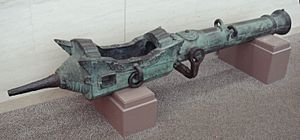
Portuguese Arrival in India
Vasco da Gama led the first European ships around Africa to India. His fleet left Lisbon in 1497. After many stops, they landed in Calicut, India, a year later. Their arrival marked the end of Muslim control over sea trade in the region. Before the Portuguese, Indian and Arab ships controlled the seas. But the Portuguese had a big advantage: cannons on their ships.
Afonso de Albuquerque and Goa's Capture
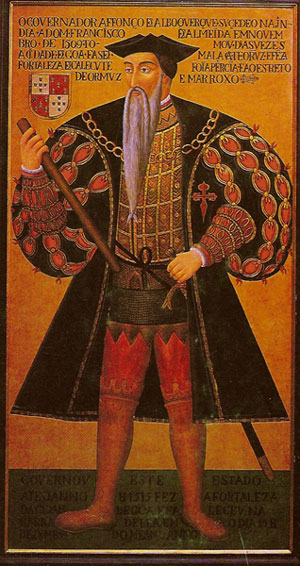
In 1510, Afonso de Albuquerque, the second Portuguese viceroy, was asked by a local chief named Timoji to take over Goa. The Portuguese quickly captured the city from Ismail Adil Shah, the ruler of the Bijapur Sultanate. But they lost it just as quickly. Albuquerque returned with a stronger force on November 25 and recaptured Goa on December 10.
Albuquerque gained support from the Hindu people by cutting their taxes in half. Goa became the center of Portuguese India. Albuquerque also started a Portuguese mint in Goa to make new coins. The Portuguese left most of the local village customs untouched, but they did abolish the practice of sati, where widows were burned on their husband's funeral pyre.
Goa became the main base for Portuguese conquests in Asia, including Malacca in 1511 and Hormuz in 1515. By the mid-16th century, the Portuguese controlled most of present-day Goa.
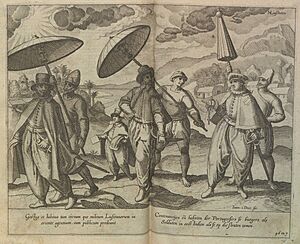
Life in Portuguese Goa
Goa reached its peak between 1575 and 1625. Travelers called it Goa Dourada, or Golden Goa. A Portuguese saying was, "He who has seen Goa need not see Lisbon." Rich houses were built of stone, painted red or white, and had gardens. Instead of glass, their windows used polished oyster-shells.
In 1583, conflicts arose in the village of Cuncolim due to Christian missionary activities. This led to the Cuncolim Revolt, where villagers killed priests. In response, Portuguese authorities attacked the village and executed many local leaders. The Goa Inquisition also began in 1560, which persecuted people who were thought to be secretly practicing their old religions. Many people left Goa because of this.
In 1556, the first printing press in India was set up at Saint Paul's College in Goa. This allowed books and knowledge from Europe to spread. The Goa Medical College was also established as the first European medical college in Asia.
Christianity in Goa
The Portuguese government supported missionary work, and many people in Goa converted to Christianity. St. Francis Xavier helped establish Saint Paul's College, the first Jesuit headquarters in Asia. This college trained Jesuit missionaries who traveled across India and even to Tibet and China.
The Jesuit order used Goa as a base to set up Catholic colleges and universities throughout Asia. The Basilica of Bom Jesus in Goa holds the body of St. Francis Xavier. Goa also has its own saints, like St. Joseph Vaz.
The Se Cathedral, built in the 16th century, is the largest church in Asia. It is dedicated to St. Catherine of Alexandria.

The Goa Inquisition was a religious court that operated in Goa from 1560 to 1812. It aimed to punish people who were thought to be secretly practicing their old religions after converting to Catholicism. It also prosecuted non-Christians who broke rules against practicing Hindu or Muslim rites. Many Jewish people who had converted to Catholicism (called New Christians) had moved to Goa but later left due to the Inquisition.
Relations with Other Powers
The Portuguese in Goa had to deal with many other powers.
- Bijapur
When the Portuguese arrived, they faced the Sultanate of Bijapur. After the Portuguese captured Goa in 1510, Bijapur remained a strong local power. In 1571, Bijapur and other Muslim sultanates attacked Goa, but the Portuguese successfully defended the city.
- Mughal Empire
Goa had good trade relations with Gujarat, which was annexed by the Mughal Empire in 1573. The Mughals and Portuguese had some conflicts but generally maintained friendly relations. The Mughals, strong on land but weak at sea, often tried to play European powers against each other.
- Dutch
In 1595, Dutch ships arrived in Indian waters. They learned Portuguese navigation secrets and began to challenge Portuguese control. The Dutch-Portuguese War led to the decline of Portuguese naval power in the Indian Ocean. In 1603 and 1639, Dutch fleets blockaded Goa, but never captured it.
- Vijayanagara
The Vijayanagara Empire was a powerful Hindu empire in South India. It was an ally of the Portuguese. The Portuguese supplied Vijayanagara with Persian horses. However, Vijayanagara was defeated in 1646 by an alliance of Deccan sultanates. After this, Goa lost much of its importance.
- Maratha Empire
The Maratha Empire to the north grew stronger. Chhatrapati Shivaji (1627-1680) captured several areas around Goa from the Portuguese. His son, Chhatrapati Sambhaji (1657-1689), tried to conquer all of Goa in 1683. He almost succeeded, but a Mughal army appeared, stopping the Maratha conquest. Later, the Portuguese reconquered some areas, forming the Novas Conquistas (New Conquests), which make up much of present-day Goa.
- English
Portugal formed an alliance with the English, which was costly. In 1665, the English demanded Bombay as part of the dowry for Catherine of Braganza's marriage to Charles II. The English and Portuguese sometimes worked together against common enemies, like the Maratha "pirate" fleet.
Goa in the 18th and 19th Centuries
In 1757, King Joseph I of Portugal declared that all subjects in Portuguese India, including Goans, were Portuguese citizens. They gained the right to be represented in the Portuguese Parliament. The areas of Goa, Damão, Diu, and Dadra and Nagar Haveli became known as the Estado da Índia Portuguesa. The first election in Goa was held in 1822, and three local citizens were elected to the Portuguese parliament.
Between 1812 and 1815, Goa was peacefully occupied by the British during the Napoleonic Wars.
The capital of Goa was moved from Old Goa to New Goa, which is today's Panaji, in 1843. Old Goa's population dropped sharply as people moved to the new city. Old Goa is now a World Heritage Site because of its history and architecture.
Second World War
Goa remained neutral during World War II, just like Portugal. Several German and Italian ships took refuge in Mormugao port. One German ship, the Ehrenfels, secretly sent information about Allied ship movements to German U-boats.
Since the British Royal Navy couldn't act against these ships due to Goa's neutrality, a secret raid was planned. Members of the Calcutta Light Horse, a civilian unit, sailed to Goa and sank the Ehrenfels. The British then bluffed, saying they would seize the territory. This made the other Axis crews sink their own ships to prevent them from being captured. This raid was kept secret until 1978 and was later made into the film The Sea Wolves.
Independence Movement
After India gained independence in 1947, Goa remained under Portuguese control. The Indian government, led by Jawaharlal Nehru, demanded that Goa be handed over to India. However, Portugal refused, saying Goa was an integral part of Portugal.
In 1954, Indian groups took over the small Portuguese areas of Dadra and Nagar Haveli. This led Portugal to complain to the International Court of Justice. In 1955, unarmed civilians protested against Portugal in Goa, and some were killed. India then closed its consulate in Goa and started a blockade to pressure Portugal.
Indian Annexation of Goa
On February 27, 1950, India asked Portugal to discuss the future of its colonies in India. Portugal insisted that Goa was not a colony but part of Portugal itself, and therefore not open for discussion. On December 18, 1961, Indian troops crossed the border into Goa. This military operation, called Operation Vijay, lasted over 36 hours. Portuguese forces surrendered unconditionally on December 19, 1961.
The United Nations Security Council proposed a resolution condemning the invasion, but the USSR vetoed it. Goa celebrates Liberation Day every year on December 19, which is a state holiday.
Goa After Annexation (1961 – present)
As a Union Territory (1961-1987)
From 1961 to 1987, Goa was part of the Goa, Daman and Diu union territory of India. Initially, Marathi was declared its official language, which angered many native Goans.
After a short period of military rule, a civilian government was set up in 1962. Dayanand Bandodkar became the first Chief Minister. He tried to merge Goa with Maharashtra, but his plans were stopped by the Goa Opinion Poll, where Goans voted to remain a separate territory.
Goa Becomes a State (1987 -present)
In February 1987, the Indian government finally recognized Konkani as the official language of Goa. In May 1987, Goa was granted full statehood within India. Pratapsingh Rane became the first Chief Minister of the new state.
Today, Goa has a high GDP per person and a high Human Development Index compared to most other Indian states.
See also
- Portuguese conquest of Goa
- Goa Inquisition
- Annexation of Goa
Images for kids
-
One of the Usgalimal rock engravings, belonging to the upper Paleolithic or Mesolithic periods. These are some of the earliest traces of human settlement in India.
-
Johannes van Doetecum's "Market of Goa", from Jan Huygen's 1596 Itinerario


